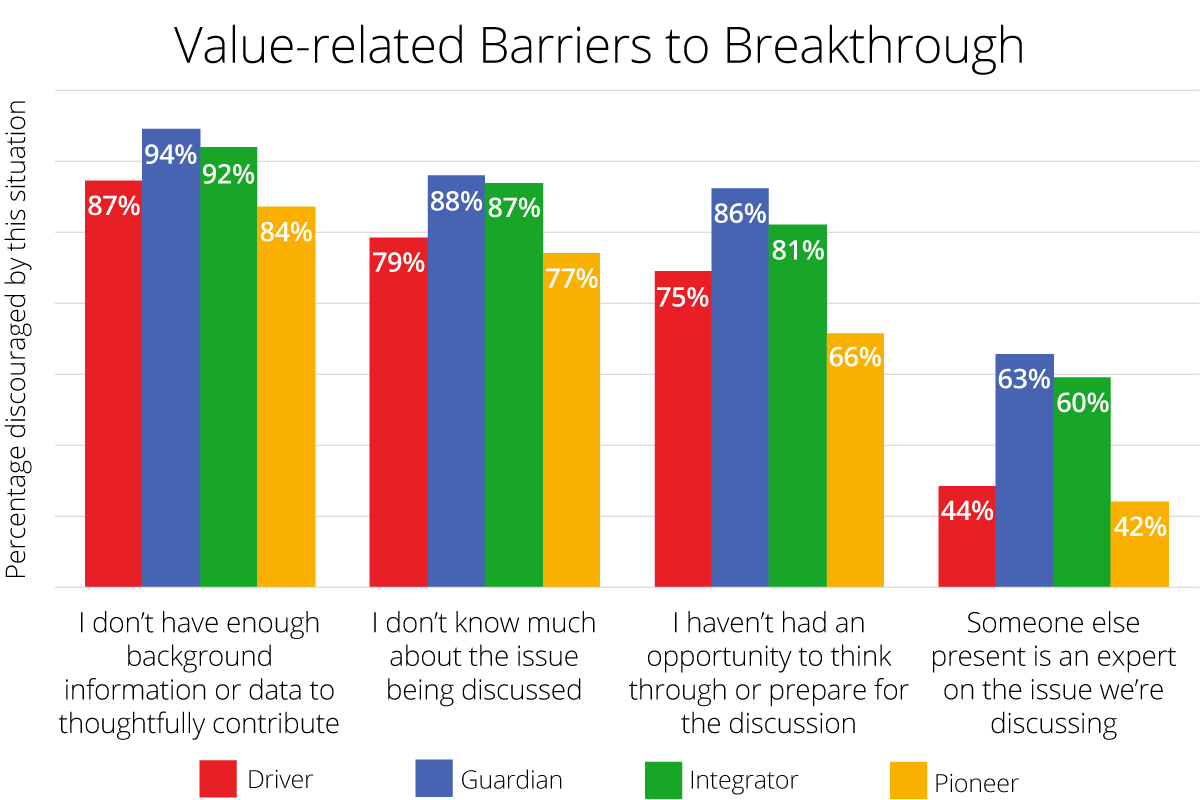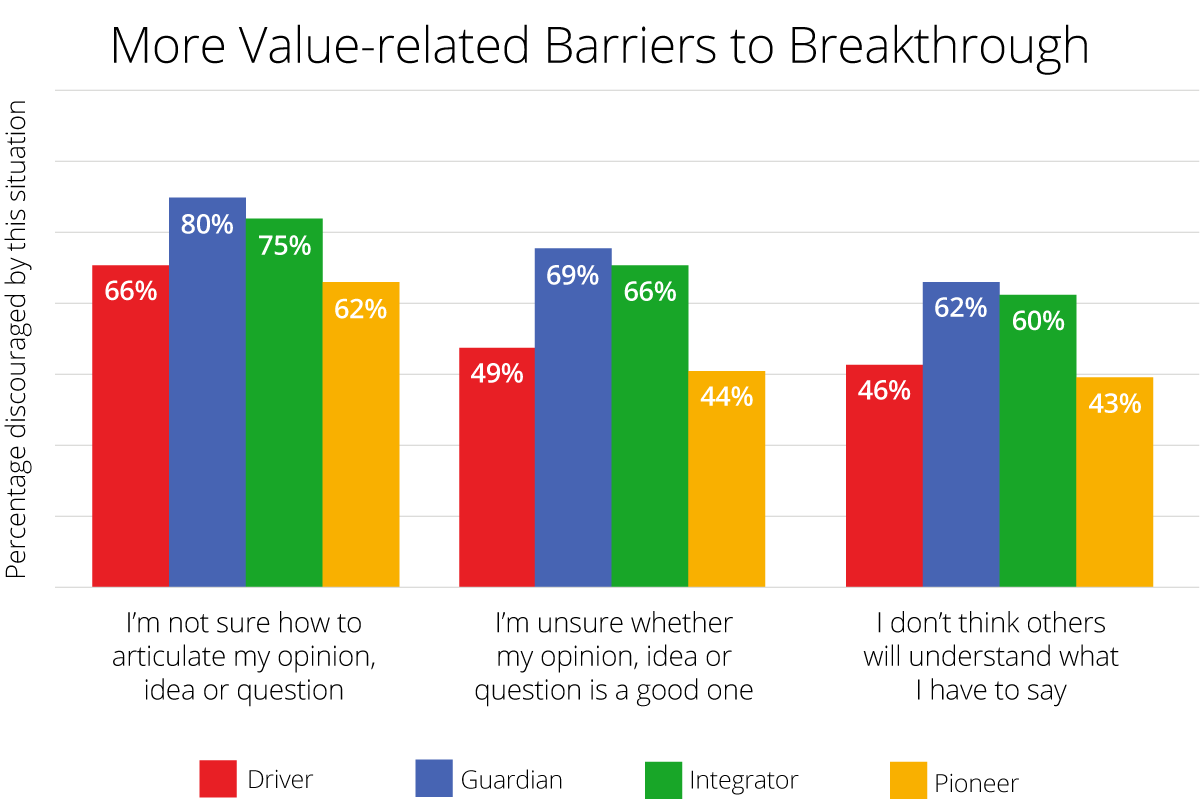Maybe This Is a Bad Idea: What Teams Lose When People Question the Value of Their Own Contributions | Deloitte US has been saved
Several months ago, I shared the results from our Deloitte Greenhouse study that explored the many reasons people might not contribute their opinions, ideas, or questions during group discussions.1 I highlighted why it’s so important to get contributions from everyone on a team—that’s how you can reap the benefits of diversity—and I outlined five categories of possible deterrents:
- Safety: Concern about negative consequences for me personally
- Value: Perceptions of how valuable my contributions are
- Impact: Perceived importance of the topic being discussed and a sense that the discussion matters
- Dynamics: How people in the room are interacting with one another
- Belonging: A sense that I can be myself and am part of the group
Here I’ll take a deeper dive into value, which comprised several of the most common reasons people may hesitate to contribute. People may stay quiet if they:
- Feel they don’t have anything valuable to add (88% of respondents might be discouraged from contributing)
- Don’t know much about the issue being discussed (83%)
- Don’t have enough background information or data to thoughtfully contribute (89%)
- Haven’t had an opportunity to think through or prepare for the discussion (77%)
- Believe someone else is an expert on the issue being discussed (52%)
- Are unsure if their opinion, idea, or question is a good one (57%)
- Aren’t sure how to articulate their opinion, idea, or question (71%)
- Don’t think others will understand what they have to say (53%)
Let’s tackle the first item first. It seems reasonable that if you don’t have anything valuable to add to a discussion, it might be better to keep quiet. Most of us have likely been in a setting where people seem to be talking just to hear themselves talk. Indeed, 12% of the respondents in our sample indicated that not having anything valuable to add would not deter them from contributing! It might be frustrating for others if these chatty colleagues take more than their share of the airtime, but perhaps they’re simply taking advantage of the babble hypothesis, whereby those who talk more are more likely to be viewed as leaders. Although it may not always be better for the group when those without anything valuable to add insist on adding it anyway, this behavior might benefit the individuals who do so.
Putting that issue aside, it remains that 88% of respondents are unlikely to make a contribution if they feel they have nothing valuable to add. But how do people determine what’s valuable? This is where it gets a bit more interesting—and also where teams can take action to get more people contributing.

Lots of people are discouraged by feeling they don’t have enough background information, don’t know much about the topic being discussed, haven’t had time to prepare, or think someone else is an expert. Especially if you want Guardians and Integrators to contribute to a discussion, you might want to pay close attention here.
One relatively easy fix for these challenges could be to provide people with more time and information in advance of a discussion so they can come prepared. It may sound simple, but don’t let the simplicity of this solution distract you from its potential power. And as simple as it may seem, can you say you always do this? Although enabling better preparation may particularly help get more Guardians and Integrators in the mix, this will likely be a rising tide lifts all boats kind of solution, as the majority of Drivers and Pioneers also indicate they may be inhibited by these issues.
Another possible solution is to clearly define for your team what a valuable contribution is—help them understand the power of a beginner’s mindset, characterized by an intense curiosity, a lack of assumptions, and a penchant for asking “naïve” questions. While many team members may be more comfortable contributing if they are informed and prepared, the value of their contributions often doesn’t depend on being so. Someone with little experience in a particular industry, field, or topic has a fresh viewpoint by default and is therefore well positioned to ask questions and make suggestions that can spark innovative approaches. Communicate to the team that a beginner’s mindset can be particularly useful when problem-solving and that you want to hear from everyone, regardless of whether they have any experience or expertise related to the topic. Share a story of someone who was inexperienced in a particular field and revolutionized it—someone like Muhammad Yunus, founder of Grameen Bank, whose story I shared in a previous post. Maybe even consider removing any experts from the room for a portion of the discussion if it makes those with less experience feel more compelled to share.

The next set of possible deterrents focuses on one’s judgements of their own potential contributions as well as their ability to express them in a way that others can grasp. While a substantial proportion of Drivers and Pioneers say they may hesitate to chime in under these circumstances, we again see significantly higher numbers for Guardians and Integrators. One interpretation of these patterns could be that Guardians and Integrators are holding themselves to a higher standard of value. In other words, Drivers and Pioneers are more likely to contribute an idea that might be half-baked, an opinion they can’t yet clearly articulate, or a question they haven’t yet fully formulated. In these situations, Guardians and Integrators may be more likely to stay silent until they have more fully processed what they want to share. Although it’s understandable to want to take a moment to clarify one’s thoughts, unfortunately, the discussion may have moved on by then, resulting in the individual who delayed missing their opportunity to contribute and the group missing out on whatever they had to share.
Tell your team that all contributions are welcome—there are no wrong opinions, bad ideas, or dumb questions when you’re brainstorming. You can set an example by sharing some thoughts of your own that aren’t yet totally coherent or fully formulated. If it helps team members get more comfortable, suggest that they can preface their offerings with phrases such as “I haven’t fully thought this through” or “I’m not sure if this makes sense.” When someone offers an idea that’s not yet fully conceptualized, ask questions that help them elaborate and clarify it. Tell a story about a “bad” idea turned into a good one. One example of such a story is about a team who wanted a better way to keep ice-coated power lines from breaking. As they brainstormed, someone suggested that instead of having people climb up power line poles to shake the ice off, they could train bears to do it. Instead of dismissing this outlandish idea, the team built on it, suggesting they put pots of honey on the top of the poles to lure the bears up. From there someone suggested they could use helicopters to put the pots in place. It seemed like quite a silly discussion overall, but suddenly, it dawned on the team that flying helicopters near the power lines would cause vibrations that could shake the ice off.
One way to show people that their ideas are valuable is by consistently responding to them as if they’re valuable. Having a structure for doing so can help make it a consistent practice on your team. Here’s a technique, popularized by Stanford Design School, that we share in our upcoming book, The Breakthrough Manifesto: 10 Principles to Spark Transformative Innovation. It can help everyone on a team acknowledge the value in each others’ ideas. Doing so will likely encourage more people to contribute more often.
I like …. I wish …. I wonder ….
- Step 1: When someone shares an idea, start with what you like about it. For example, “I like how creative and bold this idea is.”
- Step 2: Then follow up with what you’d suggest changing or would like to see more or less of. For example, “I wish we had a clearer idea about how it could work within the context of these very real barriers we’re facing.”
- Step 3: Then build on the idea or make a suggestion. For example, “I wonder if we might pressure-test the idea against those barriers one by one.” Or “I wonder what would happen if we did what you’re suggesting, but we went even bigger—like 10 times as big.”

For more on helping your teams get creative together, pre-order our new book: The Breakthrough Manifesto: 10 Principles to Spark Transformative Innovation (by Kim Christfort & Suzanne Vickberg, Wiley, 2023).
And still relevant as ever, you can also order Business Chemistry: Practical Magic for Crafting Powerful Work Relationships (by Kim Christfort & Suzanne Vickberg, Wiley, 2018).
1 Between September 2019 and March 2020, and then again between September 2020 and July 2021, all respondents who completed the online Business Chemistry assessment were asked about the conditions that would discourage them from contributing in a group setting. More than 28,000 professionals from hundreds of organizations responded.
Get in touch

Suzanne Vickberg (aka Dr. Suz)
Dr. Suz is a social-personality psychologist and a leading practitioner of Deloitte’s Business Chemistry, which Deloitte uses to guide clients as they explore how their work is shaped by the mix of individuals who make up a team. Previously serving in Deloitte’s Talent organization, since 2014 she’s been coaching leaders and teams in creating cultures that enable each member to thrive and make their best contribution. Along with her Deloitte Greenhouse colleague Kim Christfort, Suzanne co-authored the book Business Chemistry: Practical Magic for Crafting Powerful Work Relationships as well as a Harvard Business Review cover feature on the same topic. She also leads the Deloitte Greenhouse research program focused on Business Chemistry and is the primary author of the Business Chemistry blog. An “unapologetic introvert” and Business Chemistry Guardian-Dreamer, you will never-the-less often find her in front of a room, a camera, or a podcast microphone speaking about Business Chemistry or Suzanne and Kim’s second book, The Breakthrough Manifesto: Ten Principles to Spark Transformative Innovation, which digs deep into methodologies and mindsets to help obliterate barriers to change and ignite a whole new level of creative problem-solving. Suzanne is a University of Wisconsin-Madison graduate with an MBA from New York University’s Stern School of Business and a doctorate in Social-Personality Psychology from the Graduate Center at the City University of New York. She is also a professional coach, certified by the International Coaching Federation. She has lectured at Rutgers Business School and several colleges in the CUNY system, and before joining Deloitte in 2009, she gained experience in the health care and consulting fields. A mom of two teenagers, she maintains her native Minnesota roots and currently resides in New Jersey, where she volunteers for several local organizations with a focus on hunger relief.

